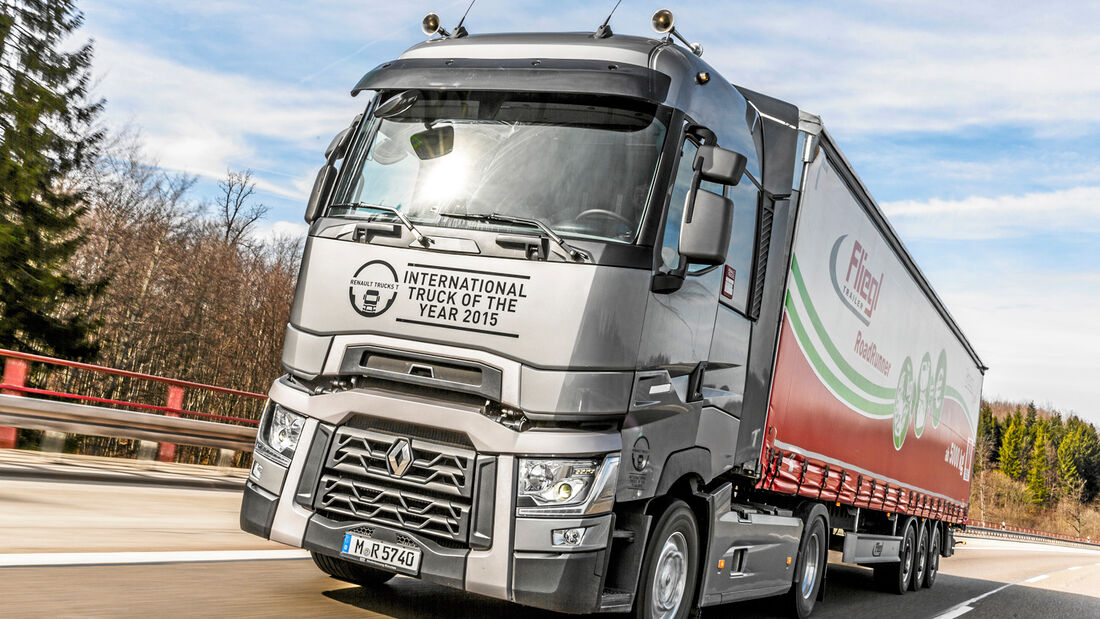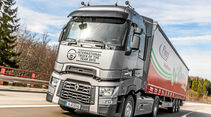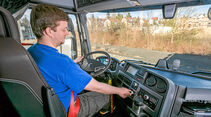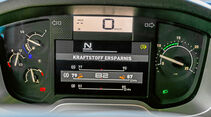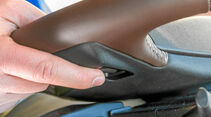When conversations focus on the Renault Trucks T, it is almost always only about the design. On our almost 2,000-km-long test drive with the French truck, this was again the case. At truck stops, people talk about the large French vehicle's appearance over and over, with the technical characteristics fading into the background. For example, there is hardly a truck driver who says a word about the most powerful version of the 13-liter engine, with no words ever wasted on the large long-haul cab, the High Sleeper Cab. Opinions differ too much on the T's appearance, which is a shame as the French truck has a lot more to offer than just an unconventional design.
Whoever wants to make a full assessment of the T should first enter the elevated driver's cab using the four steep steps above the wheel well. Once up there, a completely flat driver's cab floor is there to welcome the driver. Renault Trucks has written the omission of an engine tunnel into its product specification for the large driver's cabs. This means that the driver can move freely in the spaciously laid out living and work space.
The numerous cabinet units above the instrument panel and bed are immediately noticeable. If the Magnum occasionally had space problems when stowing everyday items, the T provides ample space with its so-called Maxispace concept. In addition to the five stowage compartments above the windshield, a further cabinet unit with three shelves replaces the upper bunk in the Maxispace driver's cab. Under the bed there is also an ample stowage compartment, which is also accessible from outside.
Storage areas very limited
Despite a lot of shelves, storage areas for documents and papers near the driver's workplace are a bit limited. Nothing can be found there in A4 format. The only alternative is the storage area on the instrument panel, under which the easily accessible fuse box is also hidden.
Before starting, taking a look at the owner's manual helps to find out about the T's special features. Even if what you are reading is not too compelling, then at least you will be comfortable doing so in the rotatable passenger seat. By rotating the seat 90°, the driver can place the tome onto the folding table above the bed when the arms start to get heavy. The table offers ample space, but an anti-slip surface, edges at the side and a cupholder would have been useful. But the latter can only be used if the driver has taken his/her drink out of the fridge before rotating the passenger seat, otherwise the electrically locked fridge drawer cannot be opened with the rotated seat blocking the way.
After studying the manual there is no longer anything stopping the start of your tour. The comfortable leather driver's seat can be smoothly positioned. Adjusting the steering wheel by pressing the button next to the steering column is harder. Unlike the Volvo FH, its counterpart in the same Group, the Renault offers only two adjustment points on the steering column instead of three. The T is lacking the last bit of tilt in the steering wheel for a permanently comfortable arm position.
Well-structured cockpit
The French flagship's futuristic and basically designed cockpit looks well-structured. All the switches are within reach, but some cannot be operated intuitively, which takes only the first few meters to find out. Before starting the engine, the driver has to enter the daily destination into the navigation system, which turns out to be difficult. The driver will search in vain to find a simple destination entry such as what TomTom, Garmin and others offer. Despite the touchscreen operation being claimed to be easy, the first attempt takes a good 10 minutes to set the first destination via the menu with its numerous levels. But it is much easier doing the second destination entry the next day.
The Renault T also requires longer periods of time of the driver to become familiarized when on the road. It is first necessary to find all the required controls, knobs and switches. For example, the controls for the instrument cluster menu navigation and the cruise control speed are hidden under the steering wheel at three and nine o'clock. However, the cruise control can be used only after the driver has chosen between limiter, cruise control (CC) and adaptive cruise control (ACC) using a rotary switch with logically arranged functions on the instrument panel. Particularly when changing between CC and ACC, feeling blindly for the instrument panel takes some practice. This can be done far more intuitively in competitors' vehicles which provide control exclusively via buttons on the steering wheel.
Engine and gear ratio combine well
After a certain period of time to become familiarized, operating the Renault T is uncomplicated. From Stuttgart, the truck goes directly onto the autobahn heading north. Right from the word go, the T520 delivers impressive driving performance and a successful shifting strategy. The combination of the 13-liter engine with 520 hp and a torque of 2,550 Nm from 1,050 revs with the highest available rear-axle gear ratio (i = 2.64) proves good for the 40-ton tractor.
The 12-speed Optidriver gearbox copes effortlessly with most driving situations. When the ACC is activated, the vehicle shifts up gears as quickly as possible, but only shifts back late if necessary. With a weaker engine, that is not always the best solution, but together with the most powerful engine, the Optidriver shows no weakness. At 85 km/h in direct drive, the T520 still has ample reserves at 1,215 revs.
Tilt sensor recognizes the course of the route
The shifting strategy is especially impressive in hilly terrain. So far, the Renault T has had to make do without an anticipatory cruise control system in the style of the I-Shift in the Volvo FH. But a tilt sensor in the transmission anticipates the course of the route. Thus, in the case of an ending incline and a set hysteresis (working in three levels) of 80 to 89 km/h at a cruising speed of 84 km/h, the software decelerates in time in the hope the vehicle weight again provides more speed after driving over the crest of the hill. This assessment is appropriate in most driving situations. On flat routes, the T also often and skillfully uses the kinetic energy of the tractor-trailer combination by means of the coasting function. A combination of Optibrake+ engine brake (414 kW) and hydraulic Voith retarder (450 kW) performs the precisely controlled permanent braking work.
In the evening, the Renault T is at a truck stop near Münster. Behind the almost lightproof curtains, a comfortable area has been quickly prepared on the pull-out bed. The sound insulation in the cab is good. Most functions can be controlled by remote control from the bed. One drawback: The driver has to set the alarm clock on the instrument cluster hidden behind the raised steering wheel, which is not really inconvenient. After showering the next morning, the driver is happy about the options for hanging up the wet towel above the bed, which at the same time serve as brackets for the on-board hammock. Already after the first day, the Renault T proves to be a useful partner in daily long-haul traffic. Ample stowage space and a comfortable bed are what distinguish the French vehicle, as well as a successful drivetrain. Many aspects of the operating concept may have been implemented arbitrarily, but the time needed to become familiarized is acceptable. The longer the tour lasts, the less significant that factor is. At the end of the 2,000-km tour, it is clear it is definitely worthwhile directing the conversation from an unconventional design to the Renault flagship's inner values.
